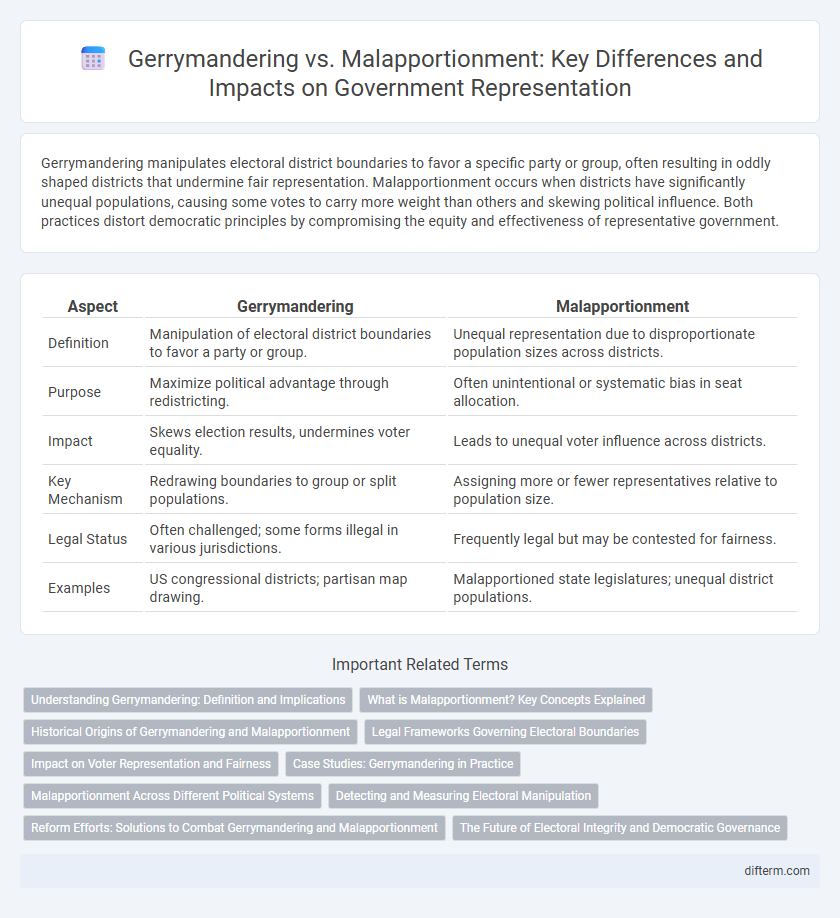Gerrymandering manipulates electoral district boundaries to favor a specific party or group, often resulting in oddly shaped districts that undermine fair representation. Malapportionment occurs when districts have significantly unequal populations, causing some votes to carry more weight than others and skewing political influence. Both practices distort democratic principles by compromising the equity and effectiveness of representative government.
Table of Comparison
| Aspect | Gerrymandering | Malapportionment |
|---|---|---|
| Definition | Manipulation of electoral district boundaries to favor a party or group. | Unequal representation due to disproportionate population sizes across districts. |
| Purpose | Maximize political advantage through redistricting. | Often unintentional or systematic bias in seat allocation. |
| Impact | Skews election results, undermines voter equality. | Leads to unequal voter influence across districts. |
| Key Mechanism | Redrawing boundaries to group or split populations. | Assigning more or fewer representatives relative to population size. |
| Legal Status | Often challenged; some forms illegal in various jurisdictions. | Frequently legal but may be contested for fairness. |
| Examples | US congressional districts; partisan map drawing. | Malapportioned state legislatures; unequal district populations. |
Understanding Gerrymandering: Definition and Implications
Gerrymandering is the practice of manipulating electoral district boundaries to favor a particular political party or group, often resulting in skewed election outcomes. This strategic redistricting dilutes the voting power of certain populations, undermining the principle of fair representation in democratic governance. Understanding gerrymandering is crucial for promoting electoral integrity and ensuring that legislative bodies accurately reflect the electorate's will.
What is Malapportionment? Key Concepts Explained
Malapportionment occurs when electoral districts are created with significantly unequal populations, leading to disproportionate representation in government bodies. This imbalance dilutes the voting power of individuals in more populated districts compared to those in less populated ones. Unlike gerrymandering, which manipulates district boundaries for political advantage, malapportionment stems from unequal population distribution without boundary manipulation.
Historical Origins of Gerrymandering and Malapportionment
Gerrymandering originated in early 19th-century America, credited to Massachusetts Governor Elbridge Gerry's 1812 redistricting plan designed to benefit his party by manipulating district boundaries. Malapportionment, contrastingly, dates back to practices in various democratic systems where unequal representation was maintained by allocating legislative seats disproportionately based on population, often favoring rural over urban areas. Both phenomena have historically distorted representative democracy by undermining the principle of equal voter influence in legislative elections.
Legal Frameworks Governing Electoral Boundaries
Legal frameworks governing electoral boundaries address gerrymandering by enforcing criteria such as contiguity, compactness, and respect for natural or political boundaries to prevent partisan manipulation of district lines. Malapportionment is regulated through population equality mandates that require districts to have nearly equal populations, ensuring equitable representation under constitutional provisions like the Equal Protection Clause in the U.S. Supreme Court rulings. Statutory measures and independent redistricting commissions in various jurisdictions aim to enhance transparency and fairness in the electoral boundary-drawing process.
Impact on Voter Representation and Fairness
Gerrymandering manipulates electoral district boundaries to favor specific political parties, significantly distorting voter representation and undermining electoral fairness by diluting the voting power of opposition groups. Malapportionment creates districts with unequal populations, leading to disproportionate representation where voters in less populated districts wield more influence than those in densely populated areas, compromising democratic equity. Both practices erode public trust and skew policy outcomes by prioritizing partisan advantage over equitable voter influence.
Case Studies: Gerrymandering in Practice
Gerrymandering manipulates electoral district boundaries to favor specific political parties, often resulting in disproportionate representation as seen in cases like North Carolina's 2016 congressional map and Maryland's 2011 redistricting. These case studies reveal how strategic boundary drawing can dilute opposition votes, enabling partisan entrenchment despite shifts in voter preference. The contrast with malapportionment, which involves uneven population distribution across districts, highlights gerrymandering's unique manipulation of voter clustering for political gain.
Malapportionment Across Different Political Systems
Malapportionment occurs when electoral districts have significantly unequal populations, leading to disproportionate representation that undermines democratic fairness. In various political systems, malapportionment manifests differently; authoritarian regimes often exploit it to maintain control, while even democracies may struggle with imbalanced districting due to geographic and demographic challenges. Addressing malapportionment requires systematic redistricting efforts guided by impartial criteria to ensure equal voter influence across constituencies.
Detecting and Measuring Electoral Manipulation
Gerrymandering involves manipulating electoral district boundaries to favor a specific party, often detected through metrics like the efficiency gap and partisan bias scores. Malapportionment occurs when electoral districts have unequal populations, measurable by the population-to-representative ratio and the deviation from ideal district size. Advanced statistical tools and geographic information systems (GIS) are essential for accurately identifying and quantifying these types of electoral manipulation.
Reform Efforts: Solutions to Combat Gerrymandering and Malapportionment
Reform efforts to combat gerrymandering and malapportionment include independent redistricting commissions that use data-driven criteria to create fair and competitive electoral maps. Legal challenges and the implementation of algorithmic districting solutions aim to enhance transparency and reduce partisan bias in district boundaries. Enhanced federal and state regulations also promote equal representation by enforcing population equality and protecting minority voting rights.
The Future of Electoral Integrity and Democratic Governance
Gerrymandering manipulates electoral boundaries to favor specific parties, undermining representative fairness, while malapportionment skews representation by creating districts with uneven populations. Ensuring the future of electoral integrity requires implementing independent redistricting commissions and adopting transparent criteria for district design. Strengthening democratic governance involves leveraging technology and data analytics to monitor electoral practices and promote accountability.
gerrymandering vs malapportionment Infographic

 difterm.com
difterm.com